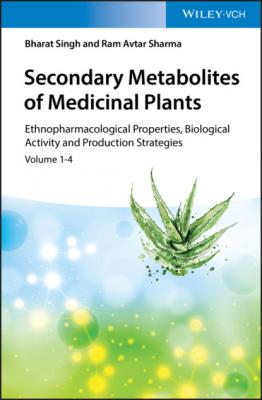Secondary Metabolites of Medicinal Plants. Bharat Singh
Читать онлайн.| Название | Secondary Metabolites of Medicinal Plants |
|---|---|
| Автор произведения | Bharat Singh |
| Жанр | Химия |
| Серия | |
| Издательство | Химия |
| Год выпуска | 0 |
| isbn | 9783527825592 |
2.7.2 Culture Conditions
The hairy roots of A. conyzoides were established with Agrobacterium rhizogenes for increasing the production of chromenes. The main compounds as β-farnesene, precocene I, and β-caryophyllene were estimated and enhanced in production in the presence of light conditions and also on the age of cultures. Precocene I, β-farnesene, precocene II, and β-caryophyllene are the main compounds of the volatile oils from the parent plant roots and, along with germacrene D, are also located in the parent plant's aerial parts. Qualitative and quantitative differences were found between the volatile oils from the roots of the parent plant and those from the hairy roots (Abdelkader and Lockwood 2011).
References
1 Aalbersberg, W.G.L. and Singh, Y. (1991). Essential oil of Fijian Ageratum conyzoides L. Flavour Fragr. J. 6: 117–120.
2 Abbiw, D.K. (1990). Useful plants of Ghana, S154–S157. Kew, London: Richmond Intermediate Technology Publication and Royal Botanic Gardens.
3 Abdelkader, M.S.A. and Lockwood, G.B. (2011). Volatile oils from the plant and hairy root cultures of Ageratum conyzoides L. Nat. Prod. Res. 25: 909–917.
4 Acheampong, F., Larbie, C., Appiah-Opong, R. et al. (2015). In vitro antioxidant and anticancer properties of hydroethanolic extracts and fractions of Ageratum conyzoides. Eur. J. Med. Plants 7: 205–214.
5 Acheampong, F., Reilly, J., Larbie, C. et al. (2017). Methoxy-flavones identified from Ageratum conyzoides induce capase-3 and -7 activations in Jurkat cells. J. Med. Plants Res. 11: 583–590.
6 Adebayo, A.H., Tan, N.H., Akindahunsi, A.A. et al. (2010a). Anticancer and antiradical scavenging activity of Ageratum conyzoides L. (Asteraceae). Pharmacogn. Mag. 6: 62–66.
7 Adebayo, H., Zeng, G.Z., Zhang, Y.M. et al. (2010b). Toxicological evaluation of precocene II isolated from Ageratum conyzoides L.(Asteraceae) in Sprague Dawley rats. Afr. J. Biotechnol. 9: 2938–2944.
8 Adesogan, E.K. and Okunade, A.L. (1978). Structure of conyzorigun, a new chromone from Ageratum conyzoides. J. Chem. Soc. Chem. Commun.: 152.
9 Adesogan, E.K. and Okunade, A.L. (1979). A new flavone from Ageratum conyzoides. Phytochemistry 18: 1863–1864.
10 Ahmed, A.A., Abou-Douh, A.M., Mohamed, A.E.H. et al. (1999). A new chromene glucoside from Ageratum conyzoides. Planta Med. 65: 171–172.
11 Bosi, C.F., Rosa, D.W., Grougnet, R. et al. (2013). Pyrrolizidine alkaloids in medicinal tea of Ageratum conyzoides. Braz. J. Pharmacogn. 23: 425–432.
12 Desai, H.K., Gawad, D.H., Govindachari, T.R. et al. (1973). Chemical investigation of Indian plants part-VII. Indian J. Chem. 11: 840–842.
13 Dũng, N.X., Tho, P.P.T., Dan, N.V., and Leclercq, P.A. (1989). Chemical composition of the oil of Ageratum conyzoides L. from Vietnam. J. Essent. Oil Res. 1: 135–136.
14 Durodola, J.I. (1977). Antibacterial property of crude extracts from an herbal wound healing remedy Ageratum conyzoides L. Planta Med. 32: 388–390.
15 Ekundayo, O., Laasko, I., and Hiltunen, R. (1988). Essential oil of Ageratum conyzoides. Planta Med. 54: 55–57.
16 Galati, E.M., Miceli, N., Taviano, M.F. et al. (2001). Anti-inflammatory and antioxidant activity of Ageratum conyzoides. Pharm. Biol. 39: 336–339.
17 Gerothanassis, I., Exarchou, V., Lagouri, V. et al. (1998). Methodology for identification of phenolic acids in complex phenolic mixtures by high resolution two-dimensional nuclear magnetic resonance. Application to methanolic extracts of two oregano species. J. Agric. Food. Chem. 46: 4185–4192.
18 Gill, S., Mionskowski, H., Janczewska, D., and Kapsa, G. (1978). Flavonoid compounds of the Ageratum conyzoides L. herb. Acta Pol. Pharm. 35: 241–243.
19 González, A.G., Aguiar, Z.E., Grillo, T.A. et al. (1984). Structure, reinvestigation of conyzorigun, a new chromone from Ageratum conyzoides. J. Chem. Soc., Perkin Trans. 1: 2945.
20 González, A.G., Aguiar, Z.E., Grillo, T.A. et al. (1991a). Methoxyflavones from Ageratum conyzoides. Phytochemistry 30: 1269–1271.
21 González, A.G., Aguiar, Z.E., Grillo, T.A. et al. (1991b). Chromenes from Ageratum conyzoides. Phytochemistry 30: 1137–1139.
22 Herz, W. and Kulanthaivel, P. (1982). Flavones from Eupatorium leucolepis. Phytochemistry 21: 2363–2366.
23 Herz, W., Govindan, S.V., Riess-Maurer, I. et al. (1980). Isolation and synthesis of two new flavones from Conoclinium coelestinum. Phytochemistry 19: 669–672.
24 Horie, T., Tominaga, H., and Kawamura, Y. (1993). Revised structure of a natural flavone from Ageratum conyzoides. Phytochemistry 32: 1076–1077.
25 Kasali, A.A., Winterhalter, P., Adio, A.M. et al. (2002). Chromenes in Ageratum conyzoides L. Flavour Fragr. J. 17: 247–250.
26 Katsuri, T.R., Thomas, E., and Abraham, E.M. (1973). Essential oil of Ageratum conyzoides: isolation and structure of two new constituents. Indian J. Chem. 11: 91–95.
27 Kerharo, J. and Adam, J.G. (1974). La Pharmacopee Senegalaise Traditionelle: Plantes Medicinales et Toxiques. Paris: Vigot.
28 Kokwaro, J.O. (1976). Medicinal Plants of East Africa. Nairobi: East African Literature Bureau.
29 Kupriyanova, G. (1997). NMR studies of the electronic structure of coumarins. J. Struct. Chem. 38: 408–414.
30 Le-Van, N. and Van Cuong Pham, T. (1979). Two new flavones from Eupatorium coelestinum. Phytochemistry 18: 1859–1861.
31 Liu, X.C. and Liu, Z.L. (2014). Evaluation of larvicidal activity of the essential oil of Ageratum conyzoides L. aerial parts and its major constituents against Aedes albopictus. J. Entomol. Zool. Stud. 2: 345–350.
32 Moazzami, A.A., Andersson, R.E., and Kamal-Eldin, A. (2007). Quantitative NMR analysis of a sesamin catechol metabolite in human urine. J. Nutr. 137: 940–944.
33 Moreira, M.D., Picanço, M.C., Barbosa, L.C.A. et al. (2007). Compounds from Ageratum conyzoides: isolation, structural elucidation and insecticidal activity. Pest. Manage. Sci. 63: 615–621.
34 Munikishore, R., Padmaja, A., Gunasekar, D., and Bodo, B. (2013). Two new flavonoids from Ageratum conyzoides. Indian J. Chem., Sect. B: Org. Med. Chem. 52: 1479–1482.
35 Nair, A.G.R., Kotiyal, J.P., and Subramaian, S.S. (1977). Chemical constituents of the leaves of Ageratum conyzoides. Indian J. Pharm. 39: 108–110.
36 Okunade, A.L. (2002). Ageratum conyzoides L. (Asteraceae). Fitoterapia 73: 1–16.
37 Palanniappan, S., Nambi, A., and Sulochana, N. (1983). Tetrhydroxyflavones from Ageratum conyzoides. Indian Drugs 27: 13.
38 Pari, K., Rao, P.J., Subrahmanyam, B. et al. (1998). Benzofuran and other constituents of essential
